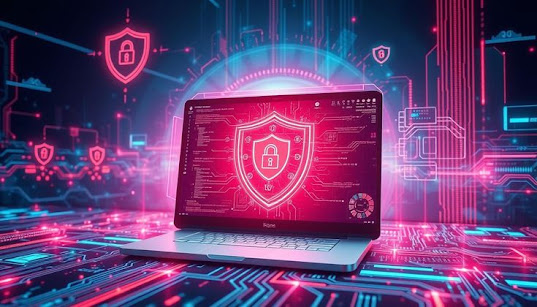Computer Network Security 2025
Computer Network Security 2025. In today’s interconnected world, your computer is more than just a machine—it’s a gateway to your personal, professional, and financial life. As the digital landscape expands, so do the risks. From identity theft and malware to phishing scams and ransomware, cyber threats are more prevalent than ever. That’s why understanding and applying proper computer security tips and safety measures is essential.
This guide walks you through practical ways to secure your computer and safeguard your digital presence—whether you’re a casual user, student, remote worker, or business professional.
A. Keep Your Operating System and Software Updated
One of the most overlooked but critical steps in computer security is keeping your system updated. Software developers continuously patch vulnerabilities that hackers can exploit.
Enable automatic updates on your Windows, macOS, or Linux systems.
-
Regularly update third-party apps, browsers, and plugins.
-
Check for firmware updates for your router and other devices.
These updates often include crucial security patches that protect your system from new threats.
B. Use Strong, Unique Passwords
Weak passwords are an open door for cybercriminals. To protect your accounts and computer:
Create complex passwords with a mix of letters, numbers, and special characters.
-
Avoid using the same password across multiple sites.
-
Use passphrases instead of simple words (e.g., "Coffee@Sunset#2025").
-
Store your passwords securely using a trusted password manager like Bitwarden, 1Password, or LastPass.
Adding two-factor authentication (2FA) wherever possible provides an additional layer of protection.
C. Install and Update Antivirus Software
Having reliable antivirus software installed is a fundamental computer security measure.
Use well-known antivirus programs like Norton, Bitdefender, Kaspersky, or Windows Defender.
-
Schedule regular system scans.
-
Ensure virus definitions are automatically updated.
Antivirus software helps detect and remove malware, trojans, ransomware, and other malicious threats before they cause harm.
D. Be Cautious with Emails and Links
Phishing remains one of the most common ways attackers trick users into revealing sensitive information or installing malicious software.
Don’t click on suspicious links or download unknown attachments.
-
Check the sender’s email address carefully—it may look legitimate but have subtle differences.
-
Avoid giving personal or financial information via email.
-
Use spam filters and report phishing attempts.
Always double-check any unexpected or urgent messages asking for sensitive information.
E. Use a Secure Internet Connection
Public Wi-Fi networks are convenient but often insecure.
Avoid accessing sensitive data like bank accounts or making purchases on public Wi-Fi.
-
Use a Virtual Private Network (VPN) to encrypt your internet traffic.
-
Secure your home Wi-Fi by changing the default router password, updating firmware, and using WPA3 encryption.
A secure internet connection helps prevent data interception and keeps your online activity private.
F. Enable Firewall Protection
A firewall acts as a barrier between your computer and the internet, monitoring incoming and outgoing traffic.
Enable the built-in firewall on your operating system.
For extra protection, consider a hardware firewall (like those found in routers).
Avoid disabling firewalls unless absolutely necessary.
Firewalls can block malicious connections and prevent unauthorized access to your computer.
G. Backup Your Data Regularly
Data loss can happen due to hardware failure, malware attacks, or accidental deletion.
-
Set up automated backups using tools like Windows Backup, Time Machine (Mac), or third-party services like Acronis or Backblaze.
-
Store backups both locally (external hard drives) and in the cloud.
-
Regularly test your backups to ensure they work when needed.
Backups are your safety net—especially in the event of a ransomware attack.
H. Be Smart About Downloads
Files from untrusted or unknown sources are one of the main ways malware enters your system.
-
Download software and files only from official websites or reputable sources.
-
Avoid clicking on flashy “Download Now” ads or pop-ups.
-
Verify the authenticity of free tools or plugins before installing them.
Being cautious with downloads can save you from costly damage and data loss.
I. Limit Administrative Access
Using your computer with full administrator rights makes it easier for malware to install itself or for system settings to be changed without your knowledge.
-
Use a standard user account for daily tasks.
-
Only switch to admin mode when making necessary changes or installing trusted programs.
-
Disable unused admin accounts and set strong passwords.
Limiting access reduces your risk of system-wide compromises.
J. Protect Your Browser and Online Activities
Since most of our computer use happens inside a web browser, it’s crucial to keep that environment secure.
-
Use privacy-focused browsers like Firefox or Brave.
-
Enable HTTPS-Only Mode to ensure secure connections.
-
Install browser extensions like uBlock Origin or Privacy Badger to block ads and trackers.
-
Clear cookies and cache regularly.
Also, consider using incognito mode for temporary browsing sessions, especially on shared devices.
K. Recognize Social Engineering Tactics
Cybercriminals often use psychological manipulation to trick users into giving away information.
-
Be skeptical of urgent requests, even if they come from someone you know.
-
Avoid oversharing on social media; attackers use this info for tailored scams.
-
Stay alert to tech support scams claiming your system has issues.
The more you understand these tricks, the less likely you are to fall for them.
L. Keep an Eye on Account Activity
Monitoring your accounts can help you catch suspicious behavior early.
-
Set up login alerts for services like email, banking, and social media.
-
Review login history and account settings regularly.
-
Report unauthorized access immediately and change your passwords.










Comments
Post a Comment